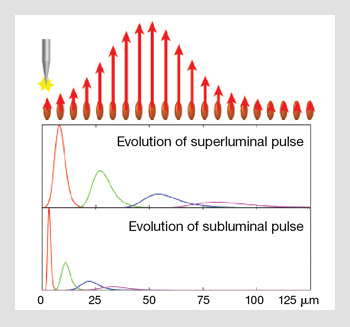Scatterings
Putting Plasmons Through Their Paces
Researchers at the University of Pennsylvania have found that a number of unusual effects are possible when light is guided along a chain of metal nanoparticles—including the generation of wave packets that move faster than the speed of light.
 (Top) Light is coupled into the first in a line of saucer-shaped metal nanoparticles. This causes the particle’s dipole moment amplitude (red arrow) to rise and fall, with a Gaussian time profile. Between-particle coupling results in the excitation of neighboring particles and propagation of a wave packet. (Bottom) Simulations of the (normalized) dipole moments along the line of particles, with different colors representing different times. The top trace simulates a superluminal pulse; the bottom, a subliminal pulse.
(Top) Light is coupled into the first in a line of saucer-shaped metal nanoparticles. This causes the particle’s dipole moment amplitude (red arrow) to rise and fall, with a Gaussian time profile. Between-particle coupling results in the excitation of neighboring particles and propagation of a wave packet. (Bottom) Simulations of the (normalized) dipole moments along the line of particles, with different colors representing different times. The top trace simulates a superluminal pulse; the bottom, a subliminal pulse.
Researchers at the University of Pennsylvania have found that a number of unusual effects are possible when light is guided along a chain of metal nanoparticles—including the generation of wave packets that move faster than the speed of light. The research, by Vadim A. Markel and Alexander Govyadinov, also suggests ways that surface plasmon-polaritons (SPPs) traveling along linear periodic chains of metal nanoparticles could be used for optical computing (Phys. Rev. B 78, 035403).
…Log in or become a member to view the full text of this article.
This article may be available for purchase via the search at Optica Publishing Group.
Optica Members get the full text of Optics & Photonics News, plus a variety of other member benefits.
